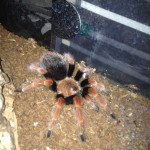Spider for sale – what to think about before buying
You typed in spider for sale but which one?
Youve typed in Spider for sale – why?
You decide you want a spider (and to be clear, by spider I am talking about tarantulas, not DWA listed true spiders). What type of spider is it best to get. Well there are a number of factors to consider and they all really depend on what you want from the spider.
First is budget. If you want an adult goliath bird eater, or a gooty ornamental you are going to need a bigger budget than if you want a chile rose spiderling. The budget you need is going to be greatly effected by all the other factors. Spiders can be cheap to aquire and to keep but if you go for one of the larger tropical species you are going to be adding to the cost and the level of skill required to look after them. Not something you are always told when you just type spider for sale into a search engine.
Lets assume you are a complete beginner, on a limited budget. What is the best one to go for when you type in spider for sale and start looking. There are a few that spring to mind based on hardiness, temperment and size. The obvious choice is the good old chile rose tarantula.
The species is very hardy and long lived (if you are getting a spiderling they are slow growing as well). They are very inexpensive to buy and do not need a huge enclosure. Obviously they get bigger than any spider you will find in the UK but are quite moderately sized compared with some of the big bird eaters or earth tigers. The vast majority are very docile (captive bred as opposed to wild caught, more on that later) and are quite slow moving in general. They come from an arid region, so you do not need to worry about maintaining raised humidity (except a little during shedding maybe). The temperature in the wild varies from very cold at night to very hot during the day, so they can easily tolerate the temperatures found in the home. Extra heating is not really required for this species (unless you know your house is normally quite cold). All of these points make it one of the best spiders around for the beginner. However there are others to consider. Other Grammostola species such as the brazilian black tarantula or the chaco golden knee tarantulaalso make good beginner spiders. The brazilian black is a bit more expensive and gets a bit bigger and the golden knee gets bigger as well, so they will need a larger enclosure as an adult. The Brachypelmas, such as the Mexican red knee tarantula are also good starter spiders, although some like the Mexican red rumpare a bit more nervous and the Mexican fire leg seems to have only one purpose in life – to flick urticating setae (hairs) at you. The ones to avoid for a beginner are the aggressive species (most of the old world and australian), those that are very fast (avicularia – not agressive but do need raised humidity and are very quick), obviously those that are very agressive and fast, like the trinidad chevron, and those that require a higher level of skill to look after. Probalbly the best examples of this are the “marsh” spiders – those species that live in very humid environements, like the fringed earth tiger.
OK, so your not a beginner. You’ve kept one, or a few spiders in the past but want something more challenging. Think about what type you want; burrowing, terrestrial or arboreal (tree living). If you go for a burrowing spider and it does burrow, you won’t see a lot of it, so you need to probably be interested in the set up as much as the spider. Maybe trying to recreate your own little piece of rainforest in you living room. This can be very rewarding in itself but you are not going to impress your friends with your big spider because they’ll never see it. Terrestrial spiders live inside or under things. Some also burrow a bit. These will be much easier to see (and clean out). Sometimes the spider will completely cover everything in web. It’s a matter of taste whether you think this looks cool or just a bit dirty. The one thing for sure is, you won’t stop the spider doing it if it wants to. Arboreal spiders like to climb. Some build web nests in crevices or branch forks (Avicularia), some like to hide under tree bark (ornamentals). Most arboreals tend to be quick and agile and can jump quite a way. Decide on what type you want first and then buy an enclosure to suit.
Next decide on what age you want to get. Spiderlings are the least expensive. However there is a reason for this. Mother nature knows not all young will make it to adulthood so most animals overproduce young. Whilst yours will not have to contend with predators, there is still “many a slip twixt cup and lip” as is were and not all will make it. A juvenile is going to be more robust, after all it is one of those that has made it so far. An adult is obviously a strong spider. However you won’t know its actual age and nothing lives forever. A lot of spiders do live a long time however (decades) so you should be OK if its a female. This is another thing to consider. Males do not live as long as females, many years less in a lot of cases. However in some species the males get a lot bigger (leg span, rather than body size) so if that’s what you want, a male might be for you. As spiderlings it can be very difficult, if not impossible to tell the difference, another reason why the cost is lower.
I would put off getting some of the more difficult or agressive species like some of the earth tigers and baboon spiders until you have had some prior experience. It is not recommended to handle any taratula, for the sake of the spider more that anything but you definitley don’t want to be handling some of the earth tigers, ornamentals and baboons. They are agressive, they can’t flick hairs so they will bite and it will really hurt. Tarantula bites are not fatal (bites should always be followed by a visit to hospital though, due to the risk of infection – you would for a dog bite wouldn’t you?) but some are quite potent and there is a risk of allergic reaction. I have a customer from Zimbabwe who was bitten by a wild baboon spider and he likened it to someone pouring molten metal on his hand for an hour before it went numb and swollen. He then suffered from muscle cramps in his neck and legs for a few weeks. Not something you want to experience. You have been warned. Obviously moving these spiders around from enclosure to enclosure is where the need for experience with spiders comes in. Disturbing a spider in its nest or burrow is when you are going to be attacked. An orange starburst baboonlept from the base of it’s enclosure at my face when I moved its hide and surprised it. It travelled aroung three feet through the air. Fortunately it missed but then it had to be captured and put back – not for the inexeperienced.
One more thing to consider before you type spider for sale and one of the most important. Wild caught or captive bred? Captive bred are generally (although as more are being bred, not always) more expensive. However wild caught are generally more aggressive and more likely to stay that way. They will almost certainly come with their own host of parasites and possibly diseases. This can have major implications if you are adding to an existing collection. Lastly, no matter what claims are made, you can have no knowledge of how the animals were collected. Was it done responsibly from areas that can sustain the harvesting of that species, or was it done by people who kill as many as they manage to collect and take from areas where they are scarce? CAPTIVE BRED IS BEST PEOPLE.
So you know enough to select the best spider for sale for you. The question is why get one at all. Well, they do make good pets. They are inexpensive, most live a long time, they are quite easy to look after and have a very low cost of maintenance. The substrate is cheap and you don’t need a lot, the enclosures are relatively small (therefore cheaper), ancillary equipment is inexpensive, they eat relatively little and the food is cheap. They are interesting to observe exhibiting their natural behaviours, which they will do as they live in quite small territories in the wild and you can make a very attractive display from their enclosure. Be warned though. keeping spiders can be quite addicitive. There are quite a few enthusiast who start with one, perhaps bought as a gift, who go on to own large collections.
If you need any specific advice from the staff on spiders (or scorpions or other invertebrates) come in and see me at the shop, or contact us on the form on the right.
Hopefully this helps a little in informing you before you type spider for sale.
See you soon
Richard



